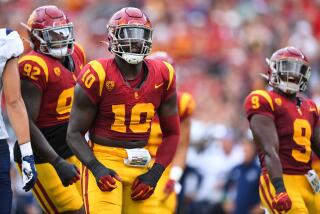Falcon Crest
Most anyone in Jamal Anderson’s shoes would be flabbergasted by such an unexpected and meteoric rise to NFL stardom.
But Anderson, the formidable running back for the Atlanta Falcons, is not anyone.
“Every time I stepped on the football field I had this thirst to be No. 1, to win,” Anderson said earlier this season.
His lips can’t be too parched anymore.
In his third season as a starter and fifth overall with the Falcons, the former El Camino Real High and Moorpark College standout is turning heads, and not just those of defenders left in his dust.
Anderson, 5 feet 11 and 234 pounds, led NFC rushers with 1,846 yards and 14 touchdowns, both team records, and set an NFL record for most rushing attempts in a season with 410. He averaged 4.5 yards per carry.
It’s no coincidence that Atlanta’s 14-2 record and NFC West Division championship, the team’s first since 1980, came as Anderson emerged as one of the league’s premier running backs. The Falcons, with the NFC’s second-best record, have a bye this week in the first round of the playoffs.
“What can you say about Jamal? It’s just incredible what he does every week,” Falcon assistant head coach Rich Brooks said recently.
Few teams apparently believed Anderson was worth a draft pick out of Utah in 1994. The Falcons took a chance with the 201st selection and now are laughing their way to perhaps the Super Bowl.
In fact, 23 running backs were chosen ahead of Anderson and virtually all are backups or no longer in the NFL. Only Marshall Faulk, taken by Indianapolis with the No. 2 pick, has more career rushing yards than Anderson among players drafted in 1994.
“I was sitting in front of the TV going, ‘Oh my God,’ ” Anderson said after the draft.
At the time, the NFL’s current trend toward big backs had not started and Anderson’s size perhaps concerned some teams. He was too big to play halfback and too fast to waste at fullback.
“It was difficult to assess where I belonged,” Anderson explained once. “I played I-formation fullback at Utah, then in the single-back formation.”
Whatever the Falcon formation, Anderson finds ways to pick up yards, even when the holes are not there. In Atlanta’s 24-17 victory at Detroit on Dec. 20, Anderson bounced off 303-pound defensive tackle Don Sasa to score a one-yard touchdown.
Anderson’s toughness and determination are nothing new. He rushed for 1,153 yards at El Camino Real in 1989, his senior season, but was primarily a blocker at Moorpark for All-American Freddie Bradley.
Once he got the chance to play as a sophomore, Anderson rushed for 1,163 yards and helped the Raiders to the Western State Bowl. He played sparingly his first year at Utah but gained 1,032 yards as a senior.
With the Falcons, Anderson again waited patiently for an opportunity. It came in 1996, when he rushed for 1,055 yards, the first of three consecutive 1,000-yard seasons. No other Atlanta player has equaled the feat.
And no other Falcon running back ever was paid what Anderson expects to get after his contract expires following the 1999 season, when he’ll make $1.6 million. He’s looking for a deal comparable to those of other top running backs, around $5 million per season.
Maybe then Anderson will pinch himself.
More to Read
Go beyond the scoreboard
Get the latest on L.A.'s teams in the daily Sports Report newsletter.
You may occasionally receive promotional content from the Los Angeles Times.










